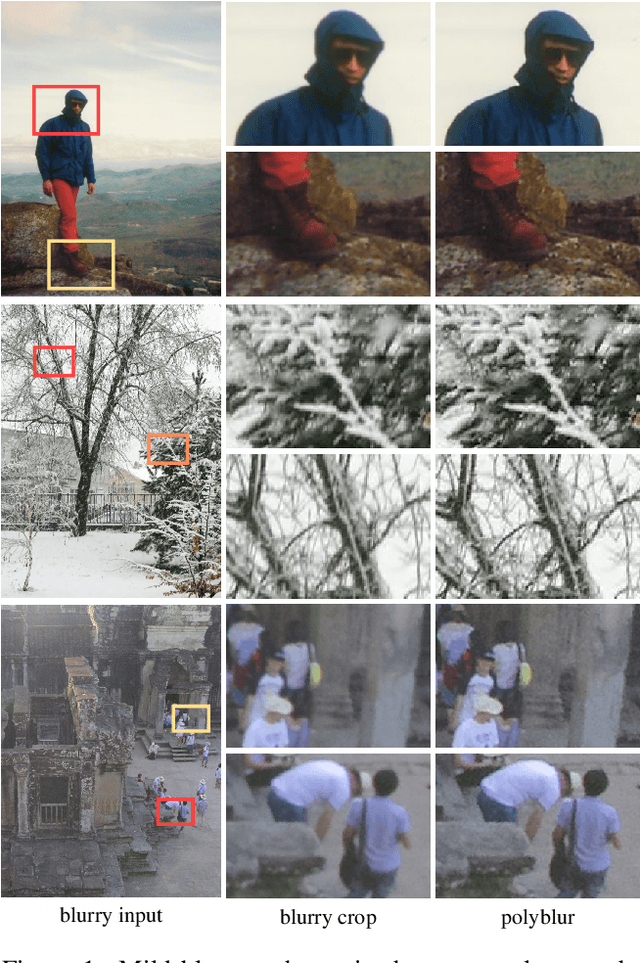Ignacio Garcia-Dorado
Polyblur: Removing mild blur by polynomial reblurring
Dec 16, 2020



Abstract:We present a highly efficient blind restoration method to remove mild blur in natural images. Contrary to the mainstream, we focus on removing slight blur that is often present, damaging image quality and commonly generated by small out-of-focus, lens blur, or slight camera motion. The proposed algorithm first estimates image blur and then compensates for it by combining multiple applications of the estimated blur in a principled way. To estimate blur we introduce a simple yet robust algorithm based on empirical observations about the distribution of the gradient in sharp natural images. Our experiments show that, in the context of mild blur, the proposed method outperforms traditional and modern blind deblurring methods and runs in a fraction of the time. Our method can be used to blindly correct blur before applying off-the-shelf deep super-resolution methods leading to superior results than other highly complex and computationally demanding techniques. The proposed method estimates and removes mild blur from a 12MP image on a modern mobile phone in a fraction of a second.
Image Stylization: From Predefined to Personalized
Feb 22, 2020



Abstract:We present a framework for interactive design of new image stylizations using a wide range of predefined filter blocks. Both novel and off-the-shelf image filtering and rendering techniques are extended and combined to allow the user to unleash their creativity to intuitively invent, modify, and tune new styles from a given set of filters. In parallel to this manual design, we propose a novel procedural approach that automatically assembles sequences of filters, leading to unique and novel styles. An important aim of our framework is to allow for interactive exploration and design, as well as to enable videos and camera streams to be stylized on the fly. In order to achieve this real-time performance, we use the \textit{Best Linear Adaptive Enhancement} (BLADE) framework -- an interpretable shallow machine learning method that simulates complex filter blocks in real time. Our representative results include over a dozen styles designed using our interactive tool, a set of styles created procedurally, and new filters trained with our BLADE approach.
Handheld Multi-Frame Super-Resolution
May 08, 2019



Abstract:Compared to DSLR cameras, smartphone cameras have smaller sensors, which limits their spatial resolution; smaller apertures, which limits their light gathering ability; and smaller pixels, which reduces their signal-to noise ratio. The use of color filter arrays (CFAs) requires demosaicing, which further degrades resolution. In this paper, we supplant the use of traditional demosaicing in single-frame and burst photography pipelines with a multiframe super-resolution algorithm that creates a complete RGB image directly from a burst of CFA raw images. We harness natural hand tremor, typical in handheld photography, to acquire a burst of raw frames with small offsets. These frames are then aligned and merged to form a single image with red, green, and blue values at every pixel site. This approach, which includes no explicit demosaicing step, serves to both increase image resolution and boost signal to noise ratio. Our algorithm is robust to challenging scene conditions: local motion, occlusion, or scene changes. It runs at 100 milliseconds per 12-megapixel RAW input burst frame on mass-produced mobile phones. Specifically, the algorithm is the basis of the Super-Res Zoom feature, as well as the default merge method in Night Sight mode (whether zooming or not) on Google's flagship phone.
Context Augmentation for Convolutional Neural Networks
Dec 12, 2017



Abstract:Recent enhancements of deep convolutional neural networks (ConvNets) empowered by enormous amounts of labeled data have closed the gap with human performance for many object recognition tasks. These impressive results have generated interest in understanding and visualization of ConvNets. In this work, we study the effect of background in the task of image classification. Our results show that changing the backgrounds of the training datasets can have drastic effects on testing accuracies. Furthermore, we enhance existing augmentation techniques with the foreground segmented objects. The findings of this work are important in increasing the accuracies when only a small dataset is available, in creating datasets, and creating synthetic images.
BLADE: Filter Learning for General Purpose Computational Photography
Dec 07, 2017



Abstract:The Rapid and Accurate Image Super Resolution (RAISR) method of Romano, Isidoro, and Milanfar is a computationally efficient image upscaling method using a trained set of filters. We describe a generalization of RAISR, which we name Best Linear Adaptive Enhancement (BLADE). This approach is a trainable edge-adaptive filtering framework that is general, simple, computationally efficient, and useful for a wide range of problems in computational photography. We show applications to operations which may appear in a camera pipeline including denoising, demosaicing, and stylization.
 Add to Chrome
Add to Chrome Add to Firefox
Add to Firefox Add to Edge
Add to Edge